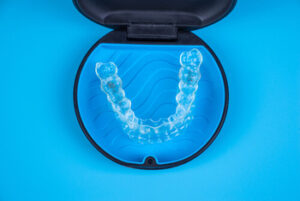In pursuing that perfect smile, modern dentistry offers a variety of options tailored to match your unique needs and aesthetic goals. Among the most popular and effective options are Invisalign and veneers—two treatments that can transform your smile, but through different means. Whether you’re looking to subtly straighten your teeth or dramatically enhance their appearance, understanding the nuances of Invisalign vs veneers is essential to making an informed choice. In this blog, we’ll explore the benefits and drawbacks of each treatment, with a focus on why veneers might be the better option for those seeking a swift, comprehensive smile makeover.
What is Invisalign?
Invisalign involves using a series of transparent aligners that gradually shift your teeth into their intended position. These clear aligners are virtually invisible, making them a popular choice for those seeking to straighten teeth discreetly. Unlike traditional metal braces, Invisalign aligners are removable, offering more flexibility during treatment.
What are Porcelain Veneers?

The Case for Veneers: Why They Might Be the Better Option
When it comes to choosing between different cosmetic dental treatments, veneers offer a compelling option for those seeking a quick and effective transformation. While both Invisalign and veneers have their merits, veneers stand out for many reasons, which include the following:
Instant Transformation
One of the most compelling advantages of veneers over Invisalign is the immediate results they provide. With veneers, you don’t have to wait months—or even years—to see a difference. Once your custom veneers are crafted, they are applied in just a couple of visits, and you leave the dental clinic with a dazzling smile. In contrast, Invisalign requires patience as your teeth gradually shift into alignment throughout the treatment.
Address Multiple Issues at Once
Veneers are a comprehensive solution that can tackle various dental issues in one go. Whether dealing with stained teeth, uneven teeth, or even gaps, veneers are applied directly to the tooth surface to enhance aesthetics by covering these imperfections and creating a uniform, flawless appearance. Invisalign is primarily focused on straightening teeth, meaning if you have multiple cosmetic concerns, additional treatments might be necessary after completing Invisalign treatment.
Durability and Longevity
Porcelain veneers are known for their strength and resilience. They can last up to 15 years with adequate care, providing a long-term solution for maintaining a beautiful smile. While effective at straightening teeth, Invisalign aligners do not offer a permanent fix. Once the treatment is completed, retainers are often required to maintain the new position of your teeth, adding an ongoing maintenance aspect that veneers do not entail.
Customisable Aesthetics
Veneers offer a level of customisation that is hard to beat. Whether you decide on porcelain veneers or composite resin, each veneer is tailored to match your natural teeth’ shape, colour, and size. This guarantees a flawless integration with your natural teeth, creating a natural look that is both striking and subtle. While effective at straightening teeth, Invisalign cannot alter the colour or shape of your teeth, meaning you may still need additional cosmetic dental treatments to achieve your desired look.
Minimal Enamel Removal
One common concern with veneers is the need for enamel removal. However, modern veneer treatment has evolved to be more conservative, requiring minimal enamel removal while still achieving a secure fit. The entire treatment process is significantly less invasive than traditional braces, which can cause discomfort and require adjustments over time. With veneers, you get an instant upgrade without the prolonged discomfort of orthodontic treatment.
Invisalign: The Slow and Steady Orthodontic Treatment Approach
Invisalign’s main advantage is that it gradually moves your teeth into place, achieving straighter teeth without needing traditional metal braces. For those who prefer a non-invasive treatment that doesn’t involve altering the natural teeth, Invisalign is a great option. The aligners are custom-made to fit your existing teeth and are changed every few weeks to continue the straightening process. This treatment option is optimal for those with mild to moderate dental misalignments.
Removable Aligners for Convenience
One of the major perks of Invisalign treatment is the ability to remove the aligners when eating, drinking, or brushing your teeth, making it easier to maintain good oral hygiene. This makes maintaining proper dental hygiene much easier than traditional braces, where food particles can become trapped in the brackets and wires. However, the convenience of removable aligners also comes with a responsibility—wearing the aligners for the recommended 20-22 hours per day is crucial for the treatment’s success.
Discreet Treatment
Invisalign aligners are clear and nearly invisible, making them a discreet choice for adults and teens alike. For those who are self-conscious about wearing braces, Invisalign offers a subtle solution. However, the discretion of Invisalign comes at the cost of time—treatment duration can range from several months to over a year, depending on the case’s complexity.
Potential Drawbacks to Keep in Mind with Invisalign
Commitment to Wearing Aligners: Invisalign aligners need to be worn for 20-22 hours a day to be effective. This requires a high level of discipline and commitment, as forgetting to wear them or not wearing them long enough can delay the treatment.

Discomfort and Speech Issues: While generally more comfortable than traditional braces, Invisalign aligners can still cause discomfort, especially when switching to a new set of aligners. Some patients also experience temporary lisping or difficulty speaking clearly when they first start wearing the aligners.
Limited Effectiveness for Complex Cases: Invisalign is highly effective for mild to moderate dental misalignments, but it may not be suitable for more complex cases that require significant tooth movement or rotation. Traditional braces or other orthodontic treatments might be necessary for these situations.
Cost: Invisalign can be more expensive than traditional braces, particularly if additional treatments or replacements are needed. While the cost varies depending on the complexity of the case, it’s something to consider when budgeting for orthodontic treatment.
Potential for Prolonged Treatment: If the aligners are not worn consistently, or if there are unforeseen issues during treatment, the duration of Invisalign treatment can extend beyond the initial estimate, delaying the final results.
Oral Health Considerations: Invisalign vs Veneers
When it comes to oral hygiene, both Invisalign and veneers require diligent care. With Invisalign, you’ll need to remove the aligners to brush and floss your teeth to make sure that no food particles are trapped under them. Since veneers are permanently attached to your teeth, they demand the same level of care as your natural teeth. Regular and consistent brushing, flossing, and regular dental check-ups are key to preserving the health and appearance of your veneers.
Impact on Dental Health
Invisalign is a non-invasive treatment that doesn’t alter the structure of your teeth, making it a suitable choice for those with healthy teeth and gums. Veneers, while requiring some enamel removal, do not typically compromise the health of your natural teeth when applied correctly by a skilled dentist. In fact, veneers can actually protect your teeth from further wear and tear, especially if you’re dealing with issues like eroded teeth or discoloured teeth.
Addressing Underlying Dental Issues
Address any underlying dental issues before proceeding with either treatment. For instance, if you have gum disease, tooth decay, or misaligned teeth, these issues should be resolved to ensure the longevity and effectiveness of your chosen treatment. Your initial consultation with a dental professional will include a comprehensive oral health assessment to determine the best course of action for your individual needs.
Cost Considerations: Is the Investment Worth It?
When comparing the cost of veneers vs Invisalign, it’s essential to consider the long-term value of each option. The cost of veneers varies according to the material used, with porcelain veneers typically being more expensive than composite veneers. However, porcelain veneers’ durability and aesthetic results often justify the higher price. While generally less expensive upfront, Invisalign treatment may require additional treatments or retainers, adding to the overall cost.
Long-Term Investment in Your Smile
Both veneers and Invisalign are investments in your smile, but the longevity of veneers often makes them a more cost-effective choice in the long run. With proper care, veneers can last over a decade, providing you with a consistently beautiful smile. Invisalign, while effective, may require ongoing maintenance and retainers to preserve the results.
Weighing the Psychological Benefits: Confidence and Self-Esteem
When considering cosmetic dental treatments, the psychological benefits can be just as significant as the physical ones. Confidence and self-esteem are strongly tied to how we feel about our appearance, and both veneers and Invisalign offer unique ways to enhance these aspects of your life. While the journey to a better smile may differ with each treatment, the end result—a boost in self-confidence—remains a common goal. Below, we explore how each option can contribute to a more confident you.
The Immediate Confidence Boost of Veneers
One of the most profound effects of getting veneers is the immediate boost in confidence that comes with unveiling your new smile. For many individuals, dental imperfections can lead to feelings of insecurity, leading them to hide their smiles or feel self-conscious in social situations. Veneers can effectively eliminate these concerns, providing you with a perfect smile that you can confidently showcase to the world.
This newfound confidence can create a ripple effect, enhancing your interactions with others, enhancing your professional image, and even encouraging you to take better care of your overall appearance. The dramatic and instant nature of the transformation makes veneers an appealing option for those who want to make a significant impact on their self-esteem.
The Gradual Confidence Build of Invisalign
While the confidence boost from Invisalign is more gradual, it’s equally impactful. As you progress through your treatment, you’ll start to notice subtle improvements in your smile, which can gradually build your self-esteem. Knowing that you’re taking steps towards a healthier, more attractive smile can be incredibly empowering, even if the results aren’t immediate.
Moreover, the discreet nature of Invisalign allows you to go about your daily life without feeling self-conscious about your treatment. This can be particularly beneficial for those in professional or social environments where appearance matters, as you can enhance your smile without drawing attention to the process.
Lifestyle Considerations: How Each Treatment Fits Your Life

Invisalign, while also relatively low-maintenance, does require a bit more attention to detail. Since the aligners must be worn for 20-22 hours a day, you’ll need to plan your meals and oral hygiene routine around your treatment. This might involve carrying a travel toothbrush or being mindful of when and where you remove your aligners. For disciplined and organised people, Invisalign can easily fit into their lifestyle, but it requires a level of commitment.
The Final Verdict: Invisalign vs Veneers?
Choosing between Invisalign and dental veneers ultimately depends on your individual dental needs and aesthetic goals. veneers stand out for their ability to deliver swift, dramatic, and comprehensive results. With veneers, you can achieve the perfect smile in just a few visits, addressing multiple cosmetic concerns at once and enjoying an instant boost in confidence.
For those who seek a solution that combines aesthetic appeal with efficiency, veneers present a compelling option that not only enhances your smile but also elevates your overall sense of self-esteem. Investing in veneers is not just about achieving a beautiful smile—it’s about embracing a transformation that can positively influence every aspect of your life.
Contact us at Dental 266 to begin your smile transformation journey today at 02 9051 0600.
References:
Cleveland Clinic. (n.d.). Dental veneers. https://my.clevelandclinic.org/health/treatments/23522-dental-veneers
Forbes. (n.d.). Composite veneers. https://www.forbes.com/health/dental/composite-veneers/
Crest. (n.d.). Oral hygiene instructions, tips & products. https://crest.com/en-us/oral-care-tips/adult/oral-hygiene-instructions-tips-products
Healthline. (n.d.). Does Invisalign work? https://www.healthline.com/health/does-invisalign-work
ResearchGate. (n.d.). Enhanced self-confidence in young adolescents with direct partial composite veneer: A case series. https://www.researchgate.net/publication/347654212_Enhanced_Self-confidence_in_Young_Adolescents_with_Direct_Partial_Composite_Veneer_A_Case_Series
Nature. (n.d.). BDJ article on veneers. https://www.nature.com/articles/sj.bdj.2009.609






